Pig farming and stable pork supply are common fundamental issues in rural economic development and social stability in China.China’s natural conditions enable farmers to focus their daily work on the farming sector, resulting in insensitivity to market information.Therefore, the contradiction between the “small-scale production” and “big market” of rural farmers is prominent.Consequently, the “company + farmers” mode is established.It is also commonly called contract farming[1].It has been increased rapidly in recent decades because of demand-side factors such as consumers’ increased incomes and supply-side factors such as technological improvement[2].
Contract farming helps transfer risks and ensures farmers’ incomes[3].It increases agricultural productivity and profitability and ensures food quality[4-6].Despite these benefits, it involves a potential conflict between companies and farmers[4].Farmer production efficiency, technical assistance, and welfare affect farmers’ decisions on whether to enter the contract[5].The contract compliance rate is low due to the unbalanced power position, lack of proper incentive mechanism, improper design, and price risk[6].
This study focuses on two major risks of pig farming.The first is market price risk, which refers to price fluctuations and the difficulty in predicting price.It is related to the number of pigs slaughtered, epidemics, climate, temperature, and other aspects.For example, a light diet in summer results in a decrease in pig demand, and the price reduces appropriately; the Spring Festival leads to more demand, and price increases appropriately.The second is production risk[2].Live pigs may die on a large scale caused by frequent epidemics.For example, the outbreak of African swine fever was first reported by the Chinese government on August 1, 2018, and all 400 pigs died in the month following the appearance of clinical signs[7].
Risk management, which has become popular in economic decisions, is characterized by minimizing the losses caused by various sources of uncertainty.Kouvelis et al.[8] proposed integrated risk management of financial and operational tools.To avoid price risk, the U.S.government provides subsidy programs to farmers[9].Applying the credit-based minimum support price scheme can induce production[10].Yield uncertainty increases fluctuation in supply and results in unstable market prices; several countries adopt the guaranteed support price scheme[11].In the lean hog futures market, Trujillo-Barrera et al.[12] estimated and evaluated ex-ante density forecasts of hog futures prices.Shen et al.[13] focused on estimating nonstationary crop yields.Jensen et al.[14] explored how basis risk and spatiotemporal adverse selection affect the demand for index-based livestock insurance.
The current study makes the following theoretical and managerial contributions.First, we develop a multiperiod game model that considers price fluctuations, which helps managers focus on long-term profits.Second, we employ the pig growth curve to estimate losses due to deaths in pig farming.Third, we derive a stable contract price interval that depends on the spot market price, quantity of pigs, breaching penalty, and transaction cost.Finally, we verify that hog insurance can reduce the losses caused by production risk, hog price index insurance can reduce the influence of price fluctuation, and the profit-returning mechanism can improve contract stability.
1 Game Model
One period is denoted by T, beginning with the breeding of piglets and ending with the sale of adult pigs.During the initial period, a company and a farmer conclude a contract stating that they will trade with each other at a contract price at the end of the period.If both players perform the contract, then they will enter the next period until the end of the contract.In this case, the contract is stable.Unfortunately, both the company and the farmer have incentives to breach contracts due to the uncertainty of spot market prices and yields.
This study aims to explore the range of contract prices within which both sides will perform the contract.This range is defined as the stable contract price interval.The larger the interval, the more stable the contract.Fig.1 depicts the decisions and processes over all periods.

Fig.1 Decisions in the game
1.1 Profit functions
Profits from the sale of livestock usually depend on weights.A pig’s weight in t days is W(t).To capture the potential growth of pigs, Gompertz model W(t)=A0e-bexp(-kt) or logistic model W(t)=A0/(1+ek(b-t))are formed[15].The three parameters have important biological meanings: A0 and k represent the mature weight and maturation rate, respectively; b is the logarithm of the ratio of the mature weight to the birth weight.
In the i-th period, a farmer’s feeding capacity is Q, which is limited, and the farmer cannot change it at will.qi pigs die at time ![]() qi∈{0,1,…,Q} is a discrete random variable, and E(qi)denotes the expectation.The average weight for each live pig is W(ti).Thus, the actual transaction weight is W(ti)(Q-E(qi))≜wi(ti), and the total weight of dead pigs is
qi∈{0,1,…,Q} is a discrete random variable, and E(qi)denotes the expectation.The average weight for each live pig is W(ti).Thus, the actual transaction weight is W(ti)(Q-E(qi))≜wi(ti), and the total weight of dead pigs is ![]()
Let subscripts A, B denote the farmer and the company, respectively.Obeying and defaulting the contract are denoted by superscripts O and D.
Case 1 If the company and farmer obey the contract during the i-th period, then the profits are
(1)
(2)
where pc denotes the contract price per unit weight of grown pigs; ![]() denotes the price per unit of the weight sold by the company at the end of the i-th period; cA,cB denote the farmer and company costs per unit weight.The total profits in N periods are
denotes the price per unit of the weight sold by the company at the end of the i-th period; cA,cB denote the farmer and company costs per unit weight.The total profits in N periods are ![]()
Case 2 If the company defaults while the farmer performs the contract, then the profits are
(3)
(4)
The company buys live pigs from the spot market at price pi and sells processed products at price ![]() fA, fB denote the cost savings of the farmer and company when a deal is made using a contract.εA, εB denote the default penalty paid by the farmer and company.The total profits in N periods are
fA, fB denote the cost savings of the farmer and company when a deal is made using a contract.εA, εB denote the default penalty paid by the farmer and company.The total profits in N periods are
Case 3 If the farmer defaults while the company performs the contract, then the profits are
(5)
(6)
The total profits in N periods are
Case 4 If both sides default, then the profits are
(7)
(8)
The total profits in N periods are
1.2 Stable interval of the contract price
If the company defaults in the j-th period, then ![]() .If the company obeys the contract, then
.If the company obeys the contract, then ![]() we obtain
we obtain
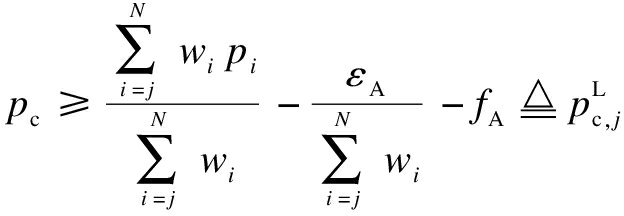
(9)
From the farmer’s perspective, we obtain
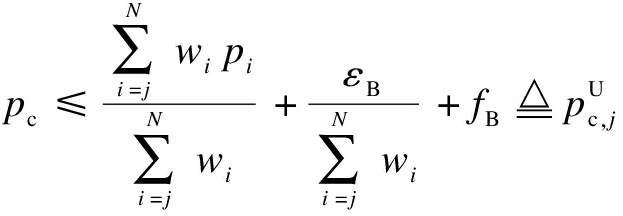
(10)
Given that ![]() , the stable interval of the contract price
, the stable interval of the contract price ![]() is nonempty.
is nonempty.
Theorem 1 In the j-th period, j∈{1,2,…,N}, both players are willing to obey the contract if ![]() ; thus, the contract is stable during this period.For all js, the stable contract price interval is
; thus, the contract is stable during this period.For all js, the stable contract price interval is ![]() , which is nonempty if and only if
, which is nonempty if and only if ![]()
This theorem states that a nonempty price interval exists and makes the contract stable for any given period.However, for all periods, a sufficient and necessary condition, that is, ![]() is needed to guarantee the nonempty property of the stable interval.Furthermore, this theorem shows that price risk and yield risk are the two major issues in contract farming.
is needed to guarantee the nonempty property of the stable interval.Furthermore, this theorem shows that price risk and yield risk are the two major issues in contract farming.
Corollary 1 For all periods, the stable interval ![]() is nonempty if
is nonempty if  This corollary proposes a sufficient condition to ensure that the stable interval is not empty for all periods.The managerial implication is that the market price fluctuates within a threshold.
This corollary proposes a sufficient condition to ensure that the stable interval is not empty for all periods.The managerial implication is that the market price fluctuates within a threshold.
1.3 Analysis of contract stability
The larger the interval length ![]() the better the stability.
the better the stability.
Corollary 2 Default penalties εA and εB have positive influences on contract stability.
Corollary 3 The saved transaction costs fA and fB have positive influences on contract stability.
Corollaries 2 and 3 indicate that the stability depends on default penalties and transaction cost savings.
Corollary 4 We treat wi as the weight, and then contract price pc should be around the weighted mean of the spot market price pi.
This corollary is illustrated by

This corollary again highlights the price risk and yield risk and gives an approximate formula for estimating the contract price.
2 Risk Control
In the hog industry, the ratio of pork price to grain price θi is commonly used to describe the market state.That is, if the pig-to-grain ratio is lower than the warning level(generally 6∶1), then the market price is depressed(pi is lower).Otherwise, the market is booming(pi is higher).As shown in Fig.2, we divide a plane into four parts according to the levels of the two risks.
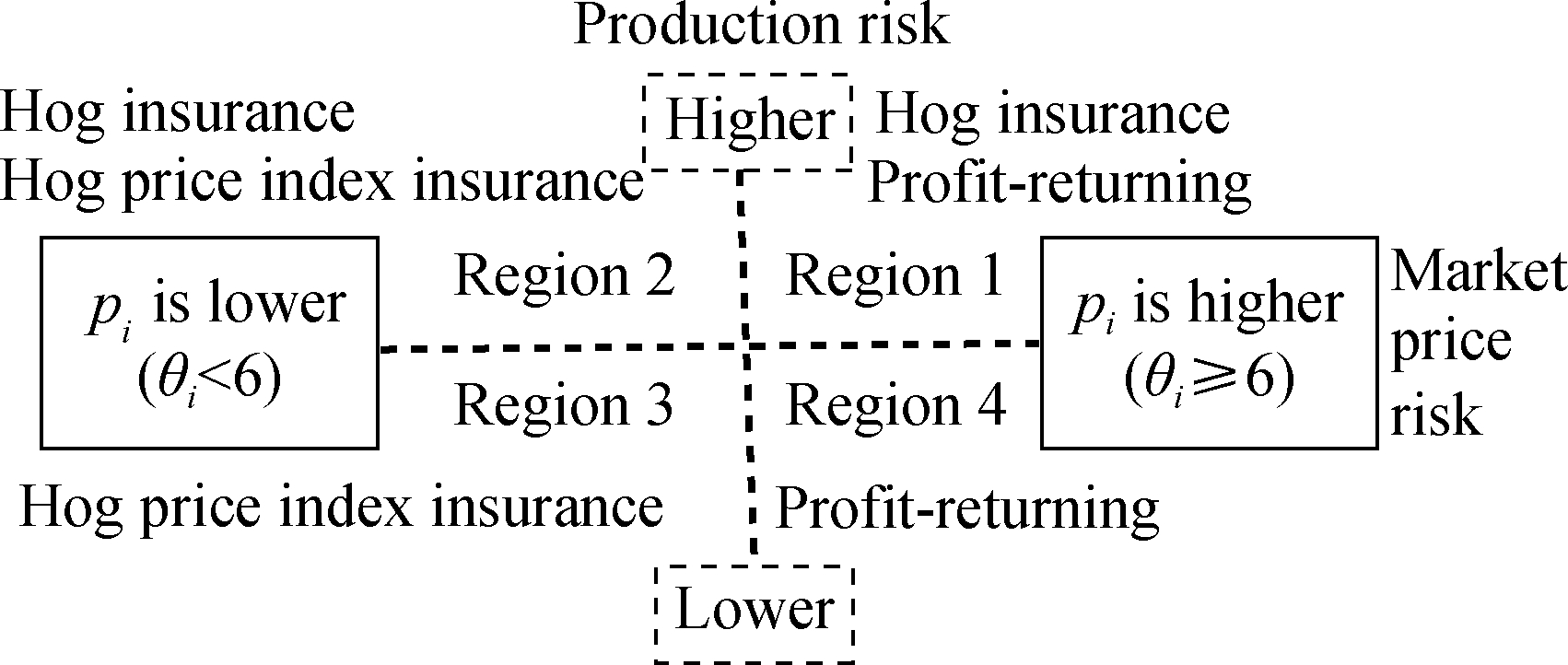
Fig.2 Working regions of different methods
To control risks, three methods are proposed.
Hog insurance works if production risk is higher(regions 1 and 2).Hog price index insurance works if the market price is lower(θi<6, regions 2 and 3).The profit-returning mechanism works when the market price is higher(θi≥6, regions 3 and 4).A comprehensive method adopts the three methods simultaneously.It works regardless of the high yield risk and whether θi is larger or less than 6(all regions).
2.1 Hog insurance to reduce production risk
The production risk is suffered by the farmer only, and the company does not suffer any loss of dead pigs.To protect the farmer’s income, it is assumed that when the two players sign a contract, the company purchases hog insurance for the pigs raised by the farmer.If the farmer fulfills the contract,then he owns the compensation.Otherwise, the compensation will be obtained by the company.Denote the insurance cost and compensation during the i-th period ![]() denote new lower and upper bounds.
denote new lower and upper bounds.
Theorem 2 Considering hog insurance, for any j∈{1,2,…,N},
1)The new steady contract price interval  is nonempty;
is nonempty;
2)The stability is improved because the length of the new interval is longer, that is, ![]()
This theorem highlights that hog insurance is effective in improving contract stability, which means this measure can be applied in practice.Moreover, the company can purchase grown pigs from the farmer at a relatively low contract price because the new interval shifts to the left, that is, 
2.2 Hog price index insurance to reduce price risk
Index insurance indemnifies policyholders on the basis of a specified “index” or some other closely related variable that is highly correlated with losses.Hog price index insurance works when the price of pigs is lower, that is, θi<6.The company tends to breach the contract because pc is higher.To avoid this default, the farmer can purchase this insurance at cost ![]() .If the company performs the contract, then he obtains the insurance compensation
.If the company performs the contract, then he obtains the insurance compensation ![]() Otherwise, the farmer gains compensation.
Otherwise, the farmer gains compensation.
Theorem 3 Considering hog price index insurance, for any j∈{1,2,…,N},
1)The new steady contract price interval is nonempty, 
2)The stability is improved if the market price plummets to an alarming level, that is, θj<6, whereas it remains the same if no such price risk exists.
This theorem shows the effectiveness of hog price index insurance against the risk of the market price collapse, which means this measure can be used in practice.The extended ratio is

Moreover, the new interval shifts to the right,that is, ![]() indicating that the company may buy grown pigs at a higher contract price.
indicating that the company may buy grown pigs at a higher contract price.
2.3 Profit-returning mechanism to the farmer
In a flourishing market, θi≥6.The farmer tends to breach the contract because the contract price is lower and the market price is higher.To retain the farmer, the company can return part of the profits as long as the farmer fulfills its obligations.Denote the amount returned per unit weight as η, and the total amount is ηwi.
Theorem 4 Considering the profit-returning mechanism, for any j∈{1,2,…,N},
1)The new steady contract price interval is nonempty,

2)The stability is improved if θj≥6, but it is unchanged if no such price risk exists.
This theorem illustrates that the profit-returning mechanism is helpful in improving the contract stability when the market price is high.The stable interval is enlarged if pj is high.The enlarged ratio is  suggesting that the company may buy grown pigs at a lower contract price.
suggesting that the company may buy grown pigs at a lower contract price.
2.4 Comprehensive method
To cover all situations, the three measures should be adopted simultaneously, which is called a comprehensive approach.
Theorem 5 Considering all three methods, for any j∈{1,2,…,N},
1)The new stable contract price interval is nonempty,


2)The stability is improved compared with the situation without any method because ![]()
3)The stability is improved compared with the separate method.
This theorem illustrates that adopting three methods simultaneously results in the best stability.It works regardless of whether the yield and price are high or low.The extended ratio is


3 Numerical Experiments
Considering eight periods, the farmer can breed 300 pigs per period.The number of mature days is approximately 200±5, and the pig weight is in line with the Gompertz curve.cA=3, cB=1, fA=1.5, fB=1, εA=εB=2, ![]() The epidemic occurs during the 6th period, resulting in 200 deaths, and the death time is approximately 150±5.The numbers of deaths in other periods are randomly distributed in the interval[1,10], and the age at death is randomly distributed in[40,200]d.
The epidemic occurs during the 6th period, resulting in 200 deaths, and the death time is approximately 150±5.The numbers of deaths in other periods are randomly distributed in the interval[1,10], and the age at death is randomly distributed in[40,200]d.
Values used in the simulation are shown in Tab.1.They are the 2014—2018 data of Henan Province derived from the China Feed Information Network(www.feedtrade.com.cn)and Pig Baba Net(www.yz88.cn).Given that pigs can be mature twice a year, we choose September 2014,March 2015,September 2015,…, March 2018 as eight periods.We calculate the average over a month because the original data are reported every day.
Tab.1 Hog, pork prices and pig-to-grain ratios

Period12345678Hogprice13.9511.5017.2518.4117.3615.4513.689.94Porkprice22.7115.9423.5627.4225.0821.9519.3314.00Pig-to-grainratio5.605.419.2011.3410.479.918.275.50
Fig.3 shows the upper and lower bounds of the steady contract price.The triangle-based line is above the dotted line, which indicates that upper and lower bounds are higher than the corresponding bounds of the basic model after adding the hog price index insurance.The star-, square-, and diamond-based lines are below the dotted line, suggesting that contract prices corresponding to these three methods decrease.
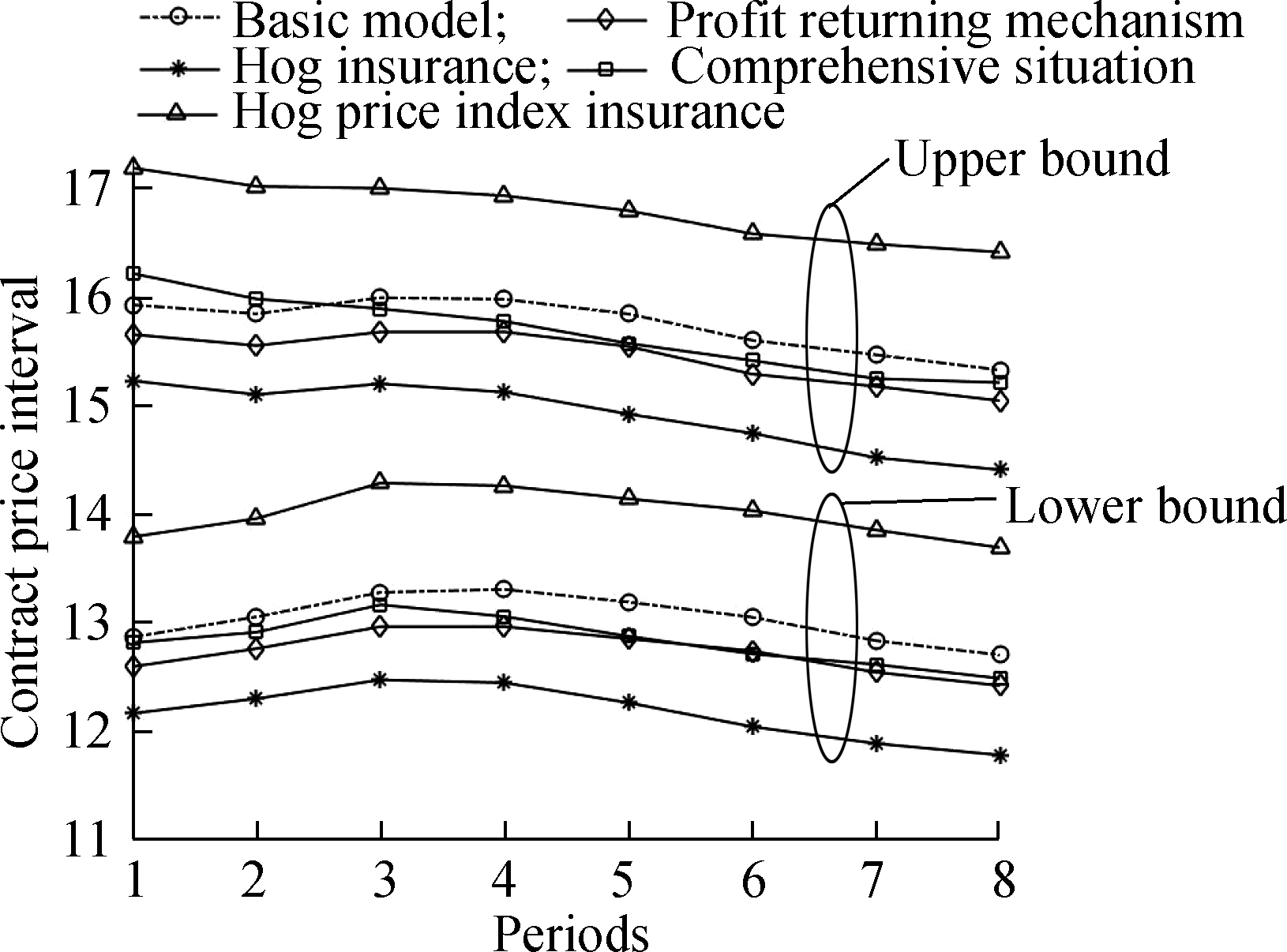
Fig.3 Upper and lower bounds
During the 6th period, pigs die on a large scale, and how hog insurance works is shown in Fig.4(a).Hog insurance increases the original stable contract price range(2.547 7 to 2.699 8), with an increase of 5.97%.Fig.4(b)illustrates that during the 1st, 2nd and 8th periods, the pig-to-grain ratios are below the warning level and hog price index insurance works.The length of the original stable contract price ranges from 3.056 1, 2.788 6, and 2.621 7 to 3.394 4, 3.056 7, and 2.718 8, showing increases of 11.07%, 9.61%, and 3.71%, respectively.During the 4th and 5th periods, the pig-to-grain ratios are greater than the normal value, and the company returns part of the profits to the farmer, as shown in Fig.4(c).The length of the original stable contract price ranges from 2.669 7 and 2.651 6 to 2.712 2 and 2.689 5.
Fig.4(d)also illustrates that the solid curve is above the dotted curve at most points, which depicts that when adopting comprehensive measures, the stable contract price range is the largest and the contract is the most stable.
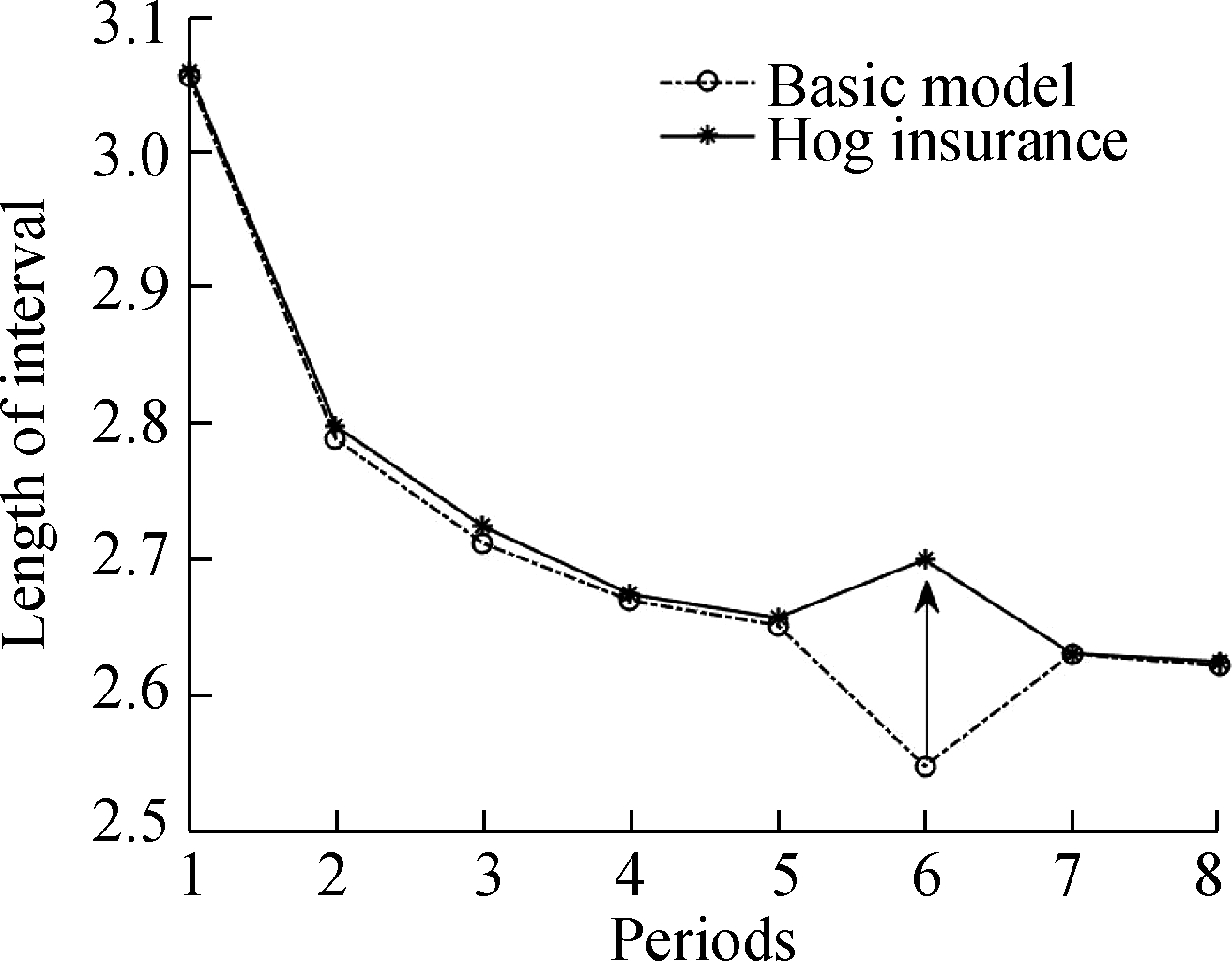
(a)
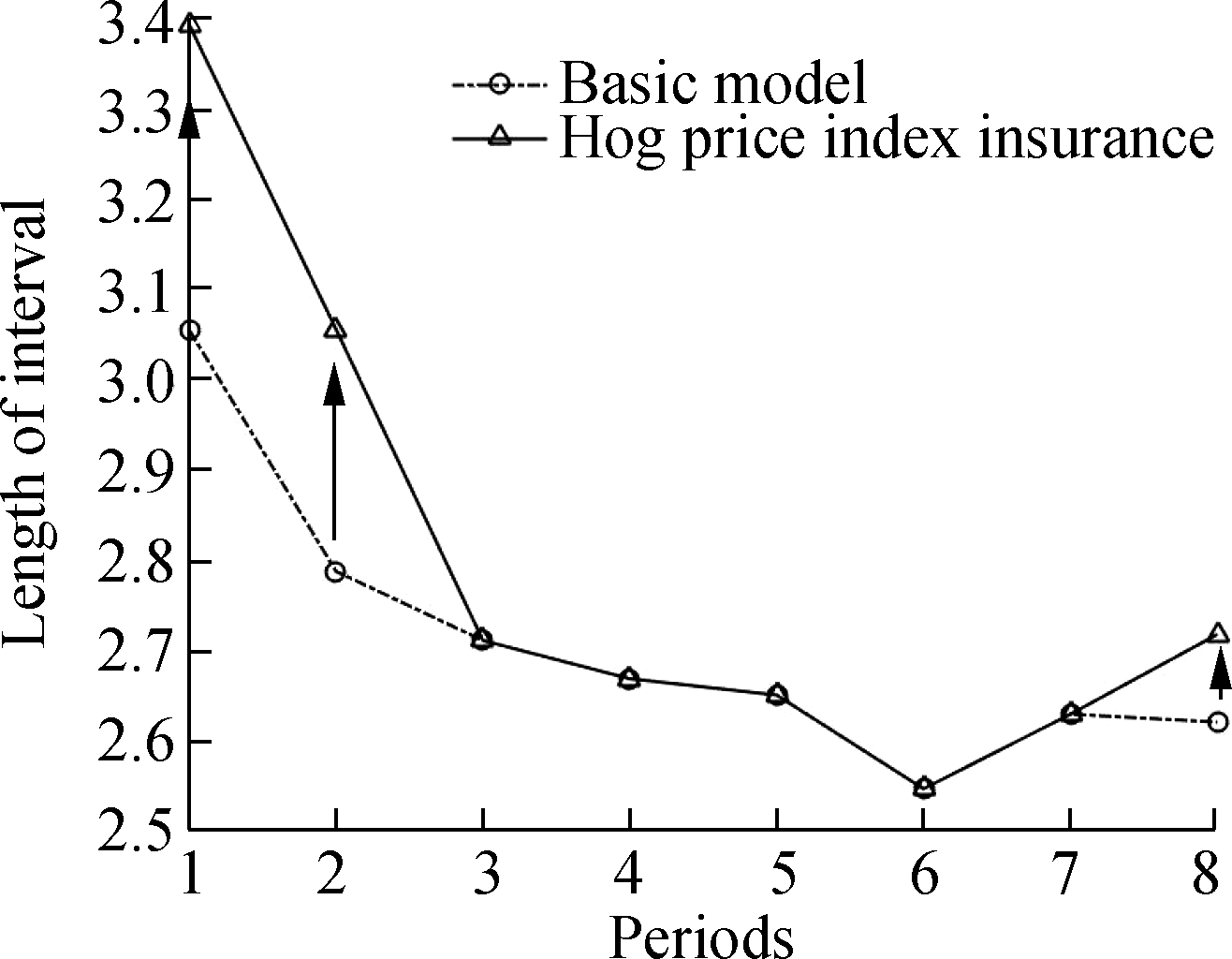
(b)
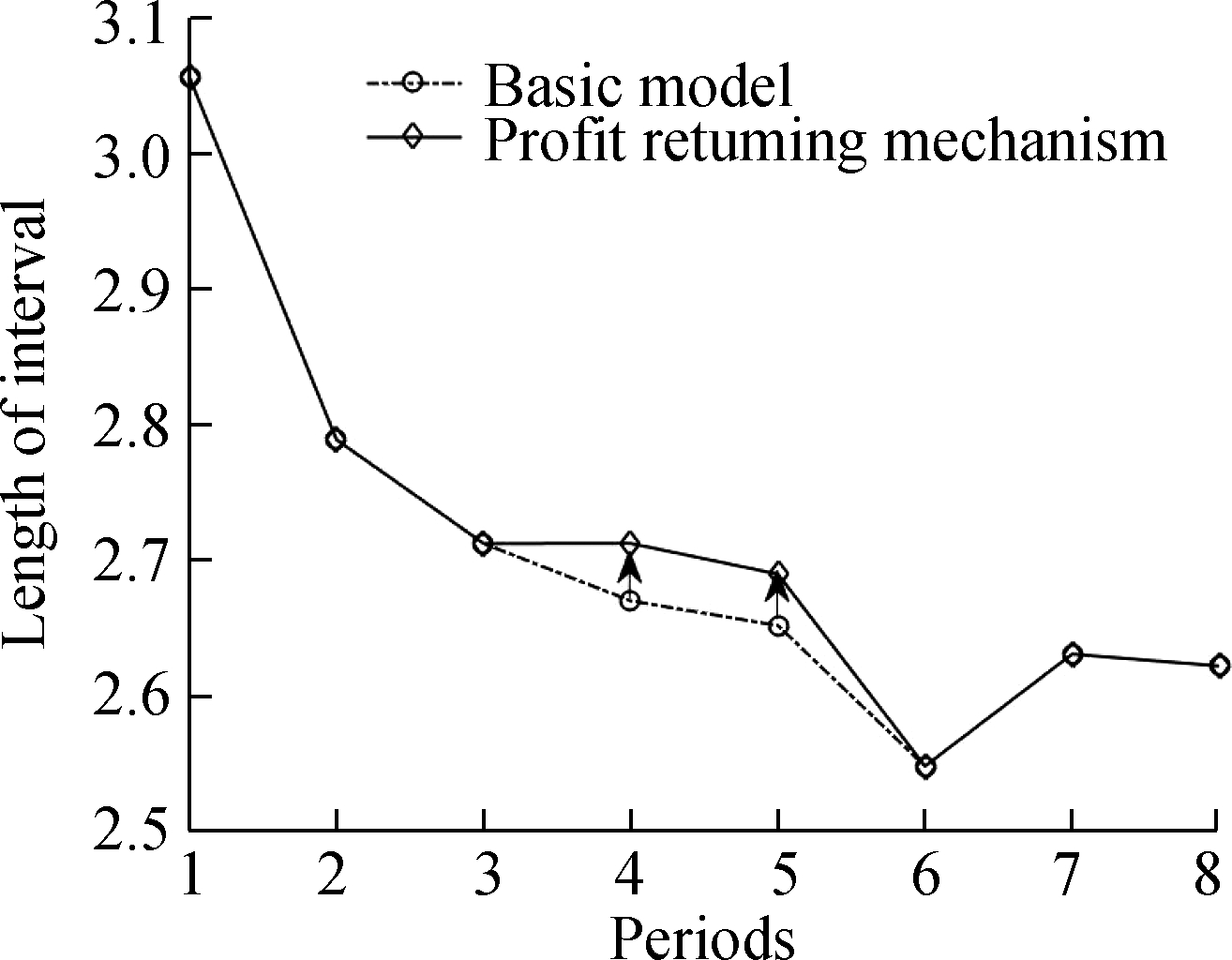
(c)
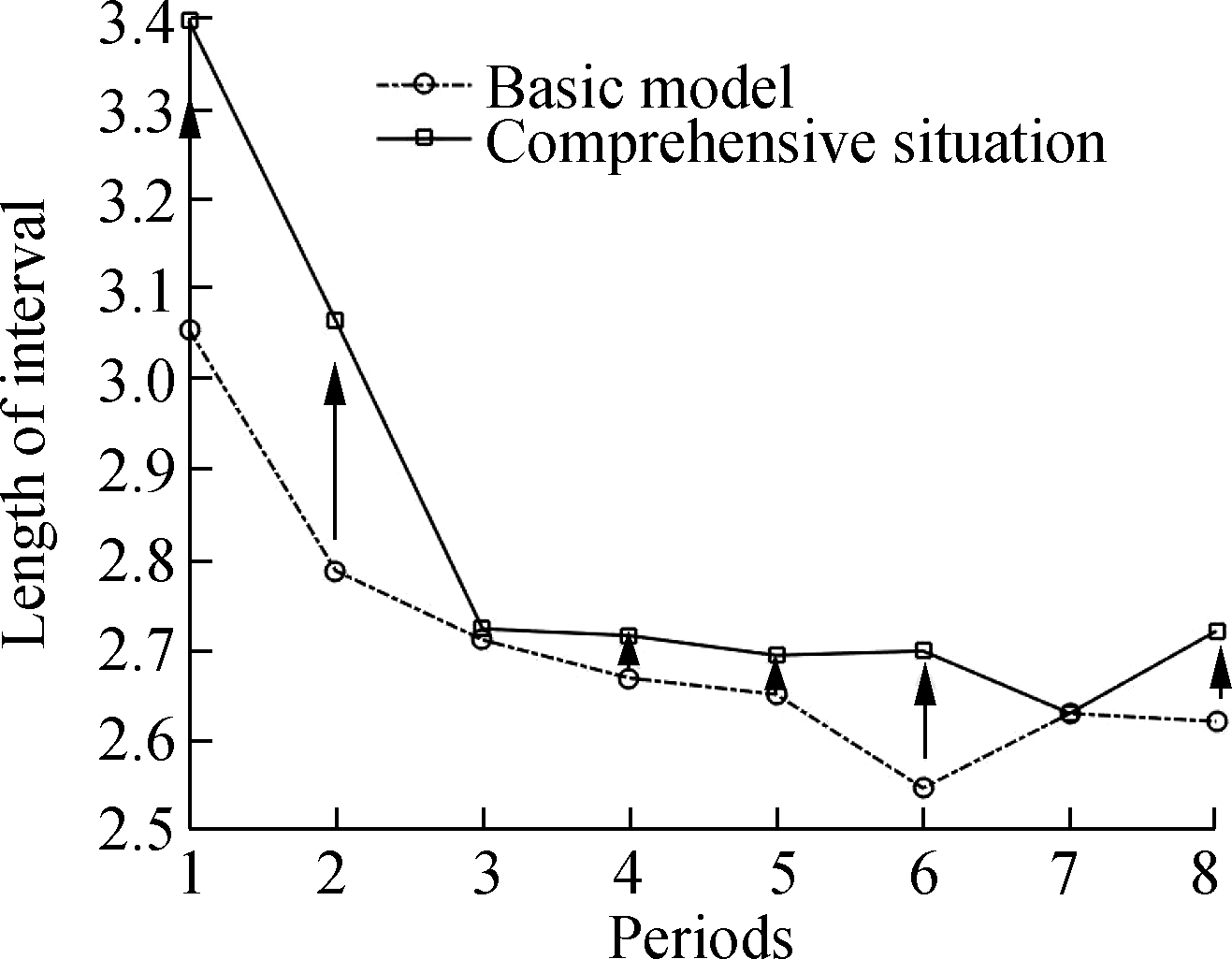
(d)
Fig.4 Length of the steady contract price interval in different situations.(a)Hog insurance;(b)Hog price index insurance;(c)Profit-returning mechanism;(d)Comprehensive situation
4 Conclusions
1)This article establishes a basic game model between a company and a farmer to investigate contract stability over multiple farming periods.The results show a nonempty interval that makes the contract stable for any period.The stability is affected by penalty and transaction cost savings—the higher the penalty, the greater the stable contract price range.The transaction costs saved through contracts have a positive effect on stability.
2)The stability is also affected by market price risk and production risk.Three measures are proposed to control risks.Hog insurance is effective against production risk, hog price index insurance is effective in protecting income when the market price is lower, and the profit-returning mechanism is effective against farmers’ default when the market price is higher.Applying the three methods simultaneously results in the best stability.
3)Managerial insights are obtained to help guide decisions in contract farming.First, the “company + farmer” mode works successfully within a nonempty space.Second, the company and the farmer can raise the penalty when signing contracts.Finally, the contract price is preferably around the weighted average of market prices.
[1] Federgruen A, Lall U, Simsek A S.Supply chain analysis of contract farming[J].Manufacturing & Service Operations Management, 2019, 21(2): 361-378.DOI:10.1287/msom.2018.0735.
[2] Mishra A K, Rezitis A N, Tsionas M G.Production under input endogeneity and farm-specific risk aversion: Evidence from contract farming and Bayesian method[J].European Review of Agricultural Economics, 2019, 47(2): 591-618.DOI:10.1093/erae/jbz027.
[3] Bellemare M F, Lee Y N, Novak L.Contract farming as partial insurance[J].World Development, 2021, 140: 105274.DOI:10.1016/j.worlddev.2020.105274.
[4] Nematollahi M, Tajbakhsh A, Mosadegh Sedghy B.The reflection of competition and coordination on organic agribusiness supply chains[J].Transportation Research Part E: Logistics and Transportation Review, 2021, 154: 102462.DOI:10.1016/j.tre.2021.102462.
[5] Chen J G, Chen Y J.The impact of contract farming on agricultural product supply in developing economies[J].Production and Operations Management, 2021, 30(8): 2395-2419.DOI:10.1111/poms.13382.
[6] Ye F, Lin Q, Li Y N.Coordination for contract farming supply chain with stochastic yield and demand under CVaR criterion[J].Operational Research, 2020, 20(1): 369-397.DOI:10.1007/s12351-017-0328-3.
[7] Ma J, Chen H,Gao X, et al.African swine fever emerging in China: Distribution characteristics and high-risk areas[J].Preventive Veterinary Medicine, 2020, 175: 104861.DOI:10.1016/j.prevetmed.2019.104861.
[8] Kouvelis P, Li R.Integrated risk management for newsvendors with value-at-risk constraints[J].Manufacturing & Service Operations Management, 2019, 21(4): 816-832.DOI:10.1287/msom.2018.0726.
[9] Alizamir S, Iravani F, Mamani H.An analysis of price vs.revenue protection: Government subsidies in the agriculture industry[J].Management Science, 2019, 65(1): 32-49.DOI:10.1287/mnsc.2017.2927.
[10] Chintapalli P, Tang C S.The value and cost of crop minimum support price: Farmer and consumer welfare and implementation cost[J].Management Science, 2021, 67(11): 6839-6861.DOI:10.1287/mnsc.2020.3831.
[11] Guda H, Dawande M, Janakiraman G, et al.An economic analysis of agricultural support prices in developing economies[J].Production and Operations Management, 2021, 30(9): 3036-3053.DOI:10.1111/poms.13416.
[12] Trujillo-Barrera A, Garcia P, Mallory M L.Short-term price density forecasts in the lean hog futures market[J].European Review of Agricultural Economics, 2017, 45(1): 121-142.DOI:10.1093/erae/jbx026.
[13] Shen Z W, Odening M, Okhrin O.Adaptive local parametric estimation of crop yields: Implications for crop insurance rate making[J].European Review of Agricultural Economics, 2017, 45(2): 173-203.DOI:10.1093/erae/jbx028.
[14] Jensen N D,Mude A G, Barrett C B.How basis risk and spatiotemporal adverse selection influence demand for index insurance: Evidence from northern Kenya[J].Food Policy, 2018, 74: 172-198.DOI:10.1016/j.foodpol.2018.01.002.
[15] Wellock I J, Emmans G C, Kyriazakis I.Describing and predicting potential growth in the pig[J].Animal Science, 2004, 78(3): 379-388.DOI:10.1017/s1357729800058781.